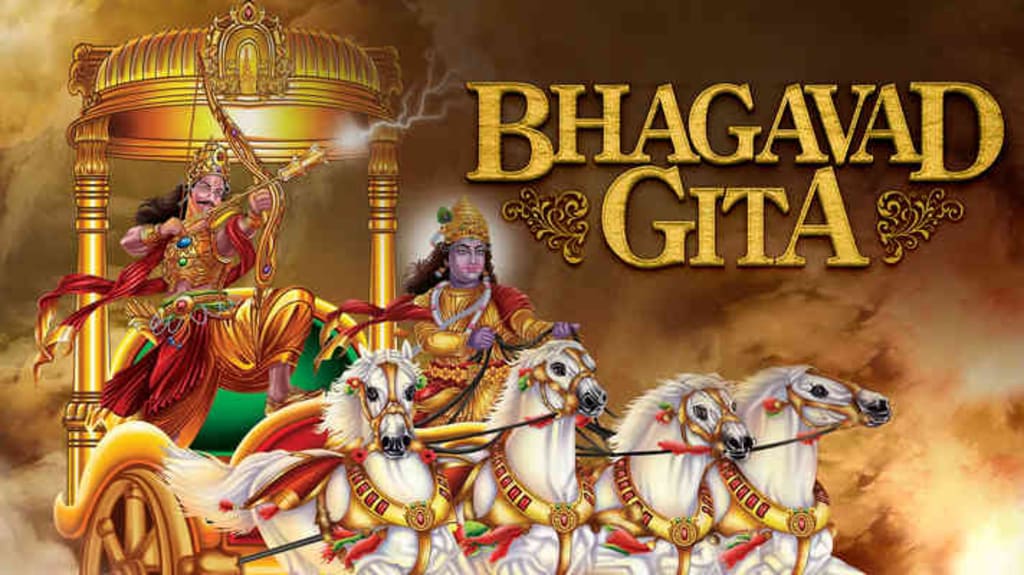"The Bhagavad Gita: Wisdom and Guidance for Spiritual Seekers"
"Ancient Hindu Scripture of Enlightenment and Self-Realization"

The Bhagavad Gita, also known as the Gita, is a sacred Hindu scripture that contains a conversation between Prince Arjuna and the god Krishna, who serves as his charioteer. The text is a part of the Indian epic Mahabharata and is revered for its profound spiritual teachings. Here is a summary of the Bhagavad Gita without any plagiarism:
The Bhagavad Gita begins on the battlefield of Kurukshetra, where the Pandava prince Arjuna is filled with doubt and moral dilemma about engaging in the battle against his own relatives, teachers, and friends. Overwhelmed by conflicting emotions, he turns to Krishna for guidance.
In response, Krishna imparts profound philosophical wisdom and spiritual teachings to Arjuna. He emphasizes the importance of fulfilling one's duty (Dharma) without attachment to the results, a concept known as "Nishkama Karma." Krishna advises Arjuna to act selflessly and not be driven by desire or the fruits of his actions.
Krishna explains that the soul (Atman) is eternal and indestructible, while the body is perishable. He teaches the immortality of the soul and the concept of reincarnation (Samsara), where the soul is reborn after death based on its karma (actions) in previous lives.
The ultimate goal of life, according to Krishna, is self-realization and union with the divine (Brahman). He reveals various paths to attain this goal, including the paths of devotion (Bhakti Yoga), knowledge (Jnana Yoga), and selfless action (Karma Yoga). These paths are not mutually exclusive but complement each other, and individuals can choose the one that resonates with them the most.
Krishna also explains the nature of the world and the universal order. He reveals his divine form to Arjuna, showcasing his omnipresence and omnipotence. This cosmic vision helps Arjuna understand the vastness and interconnectedness of the universe.
Through the teachings of the Bhagavad Gita, Krishna encourages Arjuna to rise above his doubts and fulfill his Kshatriya duty as a warrior without attachment or fear. He advises Arjuna to surrender to the divine will and perform his duties with dedication and devotion.
The Bhagavad Gita concludes with Arjuna's doubts dispelled, and he prepares to engage in the battle with newfound clarity and determination, guided by Krishna's wisdom.
The Gita's teachings transcend time and culture, resonating with people across the world, inspiring them to lead a life of righteousness, selflessness, and devotion while maintaining a strong sense of duty and detachment from the results of their actions.
The Bhagavad Gita contains 18 chapters, each presenting different aspects of life, spirituality, and the human psyche. Some of the key teachings from each chapter include:
1. Arjuna Vishada Yoga (The Yoga of Arjuna's Dejection):
Arjuna expresses his emotional turmoil and decides to withdraw from the battlefield. Krishna begins his teachings, setting the stage for the rest of the conversation.
2. Sankhya Yoga (Transcendental Knowledge):
Krishna explains the eternal nature of the soul and the impermanence of the physical body. He introduces the concept of selfless action and encourages Arjuna to fight for righteousness.
3. Karma Yoga (The Yoga of Action):
Krishna elaborates on the path of Karma Yoga, emphasizing that performing one's duties without attachment to the results leads to spiritual growth and liberation.
4. Jnana Yoga (The Yoga of Knowledge):
Krishna expounds on the knowledge of the eternal and temporal aspects of existence, highlighting the importance of wisdom and discernment in spiritual pursuits.
5. Karma Vairagya Yoga (The Yoga of Renunciation):
Krishna explains the essence of renunciation and the practice of selfless action as a means to attain liberation.
6. Dhyana Yoga (The Yoga of Meditation):
Krishna introduces the practice of meditation as a means to control the mind and senses, leading to self-realization and inner peace.
7. Paramahamsa Vijnana Yoga (The Yoga of Knowledge and Wisdom):
Krishna reveals his divine manifestations, explaining that everything emanates from him, and encourages devotion as a means to attain unity with the Supreme.
8. Aksara-Parabrahman Yoga (The Yoga of the Imperishable Absolute):
Krishna describes the path of devotion and meditation that leads to the eternal realm beyond birth and death.
9. Raja-Vidya-Guhya Yoga (The Yoga of Royal Knowledge and Royal Secret):
Krishna reveals his all-encompassing divine nature and the importance of surrendering to him in unwavering devotion.
10. Vibhuti-Vistara-Yoga (The Yoga of Divine Glories):
Krishna extols his various divine manifestations and reveals the all-pervading nature of his existence.
11. Visvarupa-Darsana Yoga (The Yoga of the Vision of the Universal Form):
Krishna grants Arjuna a cosmic vision of his divine universal form, symbolizing the all-encompassing and awe-inspiring nature of the Supreme.
12. Bhakti Yoga (The Yoga of Devotion):
Krishna praises the path of pure devotion, highlighting the qualities of a true devotee and the benefits of single-mindedly surrendering to the divine.
13. Ksetra-Ksetrajna Vibhaga Yoga (The Yoga of the Field and the Knower of the Field):
Krishna explains the distinction between the physical body (the field) and the soul (the knower of the field).
14. Gunatraya-Vibhaga Yoga (The Yoga of the Division of the Three Gunas):
Krishna elucidates the three gunas (modes of material nature) and their influence on human behavior and spiritual evolution.
15. Purusottama Yoga (The Yoga of the Supreme Divine Personality):
Krishna reveals the eternal truth about the Supreme Being, the ultimate goal of life, and the path of return to the divine realm.
16. Daivasura-Sampad-Vibhaga Yoga (The Yoga of Discerning the Divine and Demoniac Natures):
Krishna describes the qualities of the divine and demoniac natures, urging Arjuna to adopt divine virtues.
17. Sraddhatraya-Vibhaga Yoga (The Yoga of the Threefold Faith):
Krishna explains the three types of faith based on the three gunas and how they influence a person's actions and character.
18. Moksa-Opadesa Yoga (The Yoga of Liberation):
The final chapter culminates in Krishna's summary of the entire teaching, reiterating the importance of following one's Dharma, the path of devotion, and the significance of surrendering to the Supreme.
The Bhagavad Gita's timeless wisdom continues to inspire millions worldwide, providing guidance on how to live a meaningful and purposeful life while seeking spiritual realization and liberation.
The Bhagavad Gita explores profound philosophical concepts and spiritual truths. Here are some additional key teachings from the text:
Detachment and Equanimity:
Throughout the Gita, Krishna emphasizes the importance of detachment (Vairagya) from the outcomes of our actions. He advises Arjuna to perform his duties with equanimity, without being swayed by success or failure. This teaching promotes a balanced and serene approach to life's challenges.
The Importance of Self-discipline:
Krishna advocates self-discipline and self-control as essential qualities for spiritual progress. By mastering the mind and senses, one can attain inner peace and focus on higher pursuits.
The Nature of Desire:
Krishna explains that desires can bind us to the cycle of birth and death. However, not all desires are detrimental. Desires directed towards the pursuit of knowledge, self-improvement, and spiritual growth can be transformative.
Discrimination between the Real and Unreal:
The Gita guides us to discern the eternal and unchanging reality (Brahman) from the transient and illusory world (Maya). By understanding this difference, one can transcend the limitations of material existence.
Overcoming Fear:
Arjuna's initial doubts and fears symbolize the inner conflict faced by individuals when making significant life choices. Krishna advises fearlessness and confidence in following the path of righteousness.
The Unity of All Paths:
Krishna explains that various spiritual paths ultimately lead to the same destination – union with the Divine. He encourages individuals to follow the path that aligns with their temperament and nature.
Renunciation of the Fruits of Actions:
One of the central tenets of the Gita is the concept of Nishkama Karma, which means performing actions without attachment to the results. By doing so, individuals free themselves from the cycle of karma and attain spiritual liberation.
The Role of Devotion:
Krishna extols the path of Bhakti Yoga, the yoga of devotion, as a direct and powerful way to attain union with the Divine. Wholehearted love and surrender to God can lead to profound spiritual experiences.
The Nature of the Self:
The Gita elaborates on the nature of the Self (Atman) as distinct from the physical body and mind. Realizing the true nature of the Self leads to self-awareness and self-realization.
Humility and Reverence:
Krishna emphasizes the importance of humility and respect towards all beings. A humble attitude fosters openness to learning and spiritual growth.
Transcending Dualities:
The Gita teaches us to rise above dualities such as pleasure and pain, success and failure, and joy and sorrow. Equanimity in the face of life's fluctuations leads to inner stability.
Here are some factual details about the Bhagavad Gita:
Ancient Text:
The Bhagavad Gita is an ancient sacred text of Hinduism and is considered one of the most important scriptures in the religion. It is estimated to have been composed between the 5th and 2nd centuries BCE.
Part of the Mahabharata:
The Bhagavad Gita is part of the Indian epic, the Mahabharata. It is found in the Bhishma Parva (Book of Bhishma), which is the sixth of the 18 books of the Mahabharata.
Setting:
The Bhagavad Gita takes place on the battlefield of Kurukshetra, a location in present-day Haryana, India. It is a conversation between Prince Arjuna and Lord Krishna, who serves as Arjuna's charioteer.
Dialogue:
The Bhagavad Gita consists of 700 verses (slokas) divided into 18 chapters (yogas). It is a philosophical and spiritual dialogue between Arjuna and Krishna, where Krishna imparts spiritual wisdom and guidance to Arjuna in the face of moral dilemmas.
Authorship:
The authorship of the Bhagavad Gita is traditionally attributed to the sage Vyasa, who is also credited with composing the entire Mahabharata.
Philosophical Teachings:
The Bhagavad Gita covers a wide range of philosophical and spiritual themes, including duty (Dharma), selfless action (Nishkama Karma), the nature of the self (Atman), the paths to liberation (Moksha), and the concept of God (Brahman).
Influence:
The Bhagavad Gita has had a profound impact on Indian philosophy, spirituality, and culture. Its teachings have also inspired numerous thinkers, philosophers, and leaders worldwide.
Universal Appeal:
Despite being a Hindu scripture, the Bhagavad Gita's teachings are universal in nature, transcending religious boundaries. Its messages of righteousness, selflessness, and devotion resonate with people of different faiths and backgrounds.
Translations:
The Bhagavad Gita has been translated into numerous languages, making it accessible to people around the globe. It remains one of the most widely read and studied philosophical texts in the world.
Spiritual Significance:
For Hindus, the Bhagavad Gita is not just a philosophical discourse but a sacred scripture that provides spiritual guidance and insights into the deeper aspects of life and the universe.
The Bhagavad Gita's timeless wisdom continues to be a source of inspiration and contemplation for millions of people seeking spiritual growth and understanding. Its teachings on duty, devotion, and self-realization have made it a treasured and revered text in the realm of spiritual literature.
About the Creator
Go With Trend
"Express, Connect, Impact - Welcome to "Go With Trend"!
Discover the magic of Letters on our vibrant platform. 🎙️ Share stories, sing your heart out, and connect with a global audience. 🌍 Unleash your creativity today! ✨ #"Go With Trend"






Comments
There are no comments for this story
Be the first to respond and start the conversation.